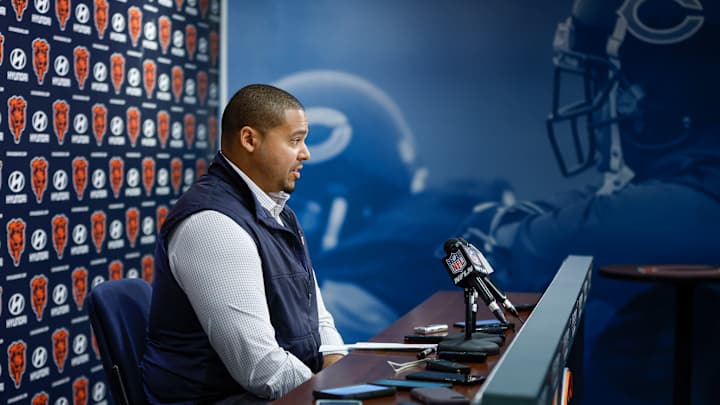No Ryan Poles Victory Lap Yet

Plunging ahead into the five weeks known as the NFL's only true offseason offers a break for reflection.
This is accomplished by Gilbert Manzano's Sports Illustrated analysis offering up what was learned from every team's offseason.
In the case of the Bears, there might be a bit too much lean toward the positive with GM Ryan Poles.
Manzano's summation about the Bears offseason is we have learned Ryan Poles is good at his job.
This could be the case. It's probably better to wait and see if the mix is right or even talented enough, but some of the reasons for Manzano's take are valid. He cited the acquisition of DJ Moore and four draft picks from Carolina for the No. 1 pick as a main reason. Another chief reason is the decision to accept Justin Fields as the QB to build their roster around, and also the signings of linebackers Tremaine Edmunds and T.J. Edwards.
It's jumping a bit too far to call the Fields decision entirely successful. It looks like it should be. All indications point that way, but if Fields falters in Year 3 are they going to be so focused in his direction when they might have at their disposal the means to get in line for one of the draft's top quarterbacks for 2024?
In fact, they might even have the top pick if Carolina collapses again.
It seems unlikely Fields would falter, but counting this as the right decision at this point is a tad premature. It was a decision that made more sense at the time than taking one of several less talented quarterbacks available in the draft for Year 2 of a rebuild.
Fields still needs to prove himself because he had too many areas to polish when last year ended.
None of this evidence offered up by Manzano as proof Poles is good at his job is a deep enough examination to overshadow what the true offseason lesson learned for the Bears is.
The real lesson from this Bears offseason is that there are limits to what $96 million can buy you when you're picky and have a lot of needs.
Poles may have done a good job engineering the trade down and signing two needed linebackers. Yet, they had the most money in free agency and plenty of draft picks and two of their biggest three needs starting the offseason remain questions. They needed an edge rusher and a good three technique, and they still don't know if they have these need spots solved.
In fact, they do know they don't have an edge rusher because they're openly talking about signing one.
Defensive end acquisitions DeMarcus Walker and Rasheem Green have never made more than seven sacks. They have no edge rushers who have. It sounds like Green and Walker will move inside to the tackle positions in some pass rush situations as a way of adding extra pressure from the interior.
"So we've done various things with that," coach Matt Eberflus said. "And with those guys that are bigger ends, you kick them inside on the third down package, which we've done that with some guys and had some success there, too."
That's fine, but again, where is the edge rush coming from if those two are inside on passing downs?
They say they don't necessarily need the big sack producer outside because the plan is for a strong interior rush with the group they have to take pressure off the outside rush. Yet that plan is based largely on second-round (Gervon Dexter) and third-round (Zacch Pickens) defensive tackles, as well as returning three technique Justin Jones.
Last year Jones had three sacks, seven quarterback hits and nine pressures. Those totals are hardly the kind to base a defensive philosophy on that revolves around the three technique.
The Lions got more quarterback hits and pressures from Isaiah Buggs on their interior defensive line last year than Jones supplied. The Packers got more pressures and QB hits there from Jarran Reed. They had more sacks, pressures and QB hits from Kenny Clark. The Vikings had more pressures and QB hits from Dalvin Tomlinson.
No one knows what the Bears will get from the two rookies at this point but Dexter was the higher pick and Eberflus wasn't talking about him like a polished pass rusher as minicamp ended. He sounded more like a project.
"He's really learning how to take off," Eberflus said. "At Florida he was more of a two-gap guy, so he was more square, moving with the offensive linemen, not moving off the ball in a takeoff position. He’s working on that. We elongated his stance a little bit to help him do that and we moved him around a little bit.
"He's playing the nose, he's playing the three."
Eberflus does like Dexter's hustle. However, this should be a prerequisite for everyone in a system governed by the HITS principle.
The Bears offseason solved some issues, but at this point $96 million and 10 draft picks without a sure way to rush the passer off the edge or a dominant interior pass rusher seems a little less like Poles did a good job and more like someone shouldn't have been so picky about how they spent money or drafted defensive linemen.
Twitter: BearDigest@BearsOnMaven
